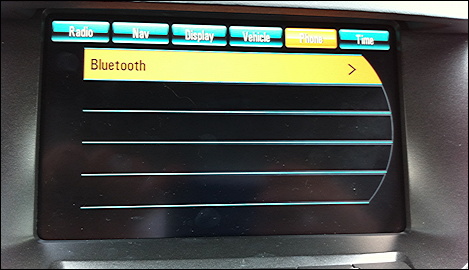
If the iPhone has the latest version of the Pandora Internet Radio application installed, you can take control of the stream using the AVIC’s touch screen to select from your Pandora stations, thumbs-up or thumbs-down songs, and bookmark artist and songs you’d like to check out later.
New to this generation of the receiver is Aha Radio support, which–through an app on a connected iPhone–means you can listen to local traffic reports, news broadcasts, restaurant reviews, and even your friends’ Facebook status updates while rolling along at highway speeds. You can select between these feeds with taps and swipes on the AVIC’s touch screen and can add or remove channels from the app itself (while the vehicle is stopped, of course.) we found it a bit odd listening to our friends’ updates in the system’s robotic text-to-speech voice, but for those of you who are addicted to social networking, this could be a cool way to catch up with your friends. There’s also a feature called Caraoke (really), which lets people share recordings of themselves singing while driving. in theory this is a fun feature, but after the first five or six submissions we checked out were either nonsense or just downright profane, we quickly removed this channel from our listing. This is, of course, a shortcoming of the Aha Radio service and not the AVIC-Z130BT, and doesn’t affect its score.
Unfortunately, iPod and iPhone connectivity requires the CD-IU51V interface cable you’ll have to purchase separately. Attempting to connect an iPhone via USB only will still give you access to all of the functions described above, but without the interface cable you won’t actually be able to hear anything, which sort of defeats the purpose.
The AVIC-Z130BT features an integrated HD Radio tuner, which we’re happy to count among the available digital audio sources. HD stations feature much clearer audio than standard ones. It takes the tuner a second to lock into the HD stream so you get a sort of before and after effect of hearing the audio suddenly become more crisp. like most HD Radio receivers these days, the AVIC’s includes the iTunes Tagging function that allows you to add songs heard on HD Radio stations to a playlist on a connected iPod or iPhone for later purchase in the iTunes Store.
GPS navigation One of the main functions in the AVIC-Z130BT’s arsenal is turn-by-turn GPS navigation. You can switch between navigation and audio/video playback with the dedicated Mode selection button. however, destination inputs are still initiated from the Home screen via the Destination menu.
Navigation includes spoken turn-by-turn directions, but does not support text-to-speech. This means that when approaching a turn, street names such as “Main Street” will not be pronounced aloud. Instead, you’ll get a simple, “Turn left in 500 feet,” for example. the navigation interface seems to have received a visual refresh since the last we saw it in the AVIC-Z120BT–certainly, since our first experience with the AVIC-Z110BT. Maps now have a crisper look that makes them easier to read, and graphic elements, such as the graphic lane guidance, now have a more polished appearance and smoother animations.
We liked that traffic data is displayed on the map. Incidents show up as small yellow icons that can be tapped for more information and flow data is represented by color-coded lines alongside the highways. a red line along a stretch of road means there’s a traffic jam. because the data is pulled from local RDS-TMC sources, you’ll usually only have flow data available for major highways with road sensors. also, the AVIC-Z130BT’s routing algorithm didn’t seem to take traffic into account when selecting a path to a destination, nor did it present alternate routes when we encountered a traffic jam. at the very least, the system does take traffic into account when calculating estimated arrival times, so you’ll know just how late you’re going to be.
We will give the AVIC-Z130BT this: the routes that the system chose for our test destinations usually lined up with our own local knowledge of the best route. we also liked that the system was extremely quick to lock in on its GPS position and remained remarkably accurate even in the urban canyons of downtown San Francisco. because the system uses a combination of internal accelerometers and a direct connection to the vehicle’s speed sensor, it’s possible that over time the system could even become more accurate as it learns the vehicle’s behaviors at a variety of speeds.
In sum the previous Pioneer AVIC-Z models are a among our favorite all-in-one receivers and a tough act to follow, but the AVIC-Z130BT still manages to impress. in one box, it has all of the cabin tech must-haves: hands-free calling, digital audio playback that’s safe and easy to use, and turn-by-turn directions with traffic. whether you’re looking to stop there or to keep going, adding rear seat entertainment, external amps, and a backup camera, you’re likely to be happy with what the AVIC-Z130BT offers. however, as good as it is, it’s not a perfect unit.
We’d like to see that iPod interface cable included in the box in the next generation; there’s no reason to have to buy that separately when iPhone app controls top the list of selling points for this unit. more importantly, we’d like to see the navigation software taking better advantage of traffic data. while we’re pushing the tech envelope, why not add an option for higher-resolution traffic data than RDS-TMC service?
If you took our advice and picked up one of the previous-generation AVIC-Z models, don’t fret. There’s not much new in the AVIC-Z130BT to give you buyer’s remorse–unless you’re a huge fan of Aha Radio, which we frankly weren’t that impressed by.
Previous page